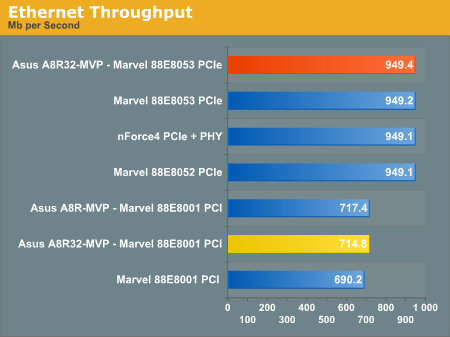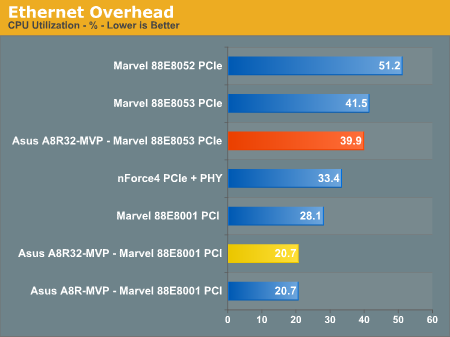Asus A8R32-MVP Deluxe: First ATI RD580
by Wesley Fink on March 1, 2006 9:00 AM EST- Posted in
- Motherboards
Ethernet Performance
The one area where the Asus A8R-MVP was mildly disappointing was in their choice of an Ethernet controller. Instead of using a PCIe LAN that is capable of providing full 1 Gb bandwidth, Asus used a PCI solution that will be limited in maximum speed by the PCI bus. The A8R32-MVP Deluxe keeps the PCI Ethernet, but it adds a second PCIe Ethernet controller capable of full bandwidth Gigabit LAN.
In practical terms, the PCI bus Ethernet is not much of a roadblock. It caps out about 700 Mb/s compared to the 950Mb/s capability of a PCIe solution. Since most broadband Ethernet connections barely tax 10Mb/s, this will really only matter to those who do sustained high-speed transfer of very large files over a true 1 Gb network - probably less than 1% of users. Still, PCIe Gigabit Ethernet is always a better solution, and it is good to see that Asus addressed this issue in the A8R32-MVP.
The Windows 2000 Driver Development Kit (DDK) includes a useful LAN testing utility called NTttcp. We used the NTttcp tool to test Ethernet throughput and the CPU utilization of the various Ethernet Controllers used on the AMD motherboards.
We set up one machine as the server; in this case, an Intel box with an Intel CSA Gigabit LAN connection. Intel CSA has a reputation for providing fast throughput and this seemed a reasonable choice to serve our Gigabit LAN clients. At the server side, we used the following Command Line as suggested by the VIA whitepaper on LAN testing:
The one area where the Asus A8R-MVP was mildly disappointing was in their choice of an Ethernet controller. Instead of using a PCIe LAN that is capable of providing full 1 Gb bandwidth, Asus used a PCI solution that will be limited in maximum speed by the PCI bus. The A8R32-MVP Deluxe keeps the PCI Ethernet, but it adds a second PCIe Ethernet controller capable of full bandwidth Gigabit LAN.
In practical terms, the PCI bus Ethernet is not much of a roadblock. It caps out about 700 Mb/s compared to the 950Mb/s capability of a PCIe solution. Since most broadband Ethernet connections barely tax 10Mb/s, this will really only matter to those who do sustained high-speed transfer of very large files over a true 1 Gb network - probably less than 1% of users. Still, PCIe Gigabit Ethernet is always a better solution, and it is good to see that Asus addressed this issue in the A8R32-MVP.
The Windows 2000 Driver Development Kit (DDK) includes a useful LAN testing utility called NTttcp. We used the NTttcp tool to test Ethernet throughput and the CPU utilization of the various Ethernet Controllers used on the AMD motherboards.
We set up one machine as the server; in this case, an Intel box with an Intel CSA Gigabit LAN connection. Intel CSA has a reputation for providing fast throughput and this seemed a reasonable choice to serve our Gigabit LAN clients. At the server side, we used the following Command Line as suggested by the VIA whitepaper on LAN testing:
Ntttcps -m 4 ,0,‹client IP› -a 4 -l 256000 -n 30000On the client side (the motherboard under test), we used the following Command Line:
Ntttcpr -m 4 ,0,‹server IP› -a 4 -l 256000 -n 30000At the conclusion of the test, we captured the throughput and CPU utilization figures from the client screen.












65 Comments
View All Comments
SuperStrokey - Friday, February 17, 2006 - link
i assume that was not the gtx512 was it? If so wowDeathBooger - Friday, February 17, 2006 - link
http://www.scan.co.uk/Products/ProductInfo.asp?Web...">http://www.scan.co.uk/Products/ProductInfo.asp?Web...If you do a currency conversion it's $217USD. Some lucky guy actually got to buy it before they were supposed to sell it. http://forums.overclockers.co.uk/showthread.php?t=...">http://forums.overclockers.co.uk/showthread.php?t=...
Egglick - Friday, February 17, 2006 - link
Why would you use two different videocards when benchmarking a motherboard?? This really tells us nothing about the motherboards performance in relation to the others, because you have another huge variable.Wesley Fink - Friday, February 17, 2006 - link
As we stated in the test setup we ran BOTH the 7800GTX and the X1900XT video card on the Asus A8R32-MVP. We reported both results so you could compare 7800GTX performance to the previous boards also tested with the 7800GTX. Since the X1900XT is the latest and fastest video card the results were included for Reference only - many would have asked for X199XT results if they were excluded.As someone else pointed out, when testing Dual X16 Video you have to run SLI on nVidia and Crossfire on ATI (or Intel).
andrewln - Friday, February 17, 2006 - link
because you can not run SLI in Crossfire motherboardstuteja1986 - Friday, February 17, 2006 - link
Why didn't Asus include the cool feel as they did with the ASUS A8N 32-SLI. Like the 8-Phase Power and the cool looking Fanless Motherboard cooling system.mino - Friday, February 17, 2006 - link
Just wondering. maybe 8-phase is a waste for ~60 watt Athlon64s. Also why do a fancy(an expensive) "cool looking Fanless Motherboard cooling system" when chipset is cool and doesn not need one at all???I.m glad someone has a sense and doesn't produce third central heater in the system(after CPU & GPU).
Hoping SB600 will be a good one.
Wesley Fink - Friday, February 17, 2006 - link
The RD580 chipset also ran very cool on this board, so there may not be the need for the more exotic passive heatpipe cooling used on the A8N32-SLI.Wesley Fink - Friday, February 17, 2006 - link
The A8R32-MVP was designed to sell for a lower price - probably around $130 to $150, where the A8N32-SLI was designed to sell for $200+. While the A8R32-MVP isn't 8-phase, it actually overclocked ba bit better and gave up nothing to the more expensive and excellent A8N32-SLI in performance. This board can also run dual X1900XT cards in Crossfire mode.tuteja1986 - Friday, February 17, 2006 - link
I wonder how much will it sell for and if it goes arround same price as Asus A8N 32-SLI (220ish). if it cost that much then i will end up buying DFI RD580 motherboard if its got no issue bugs like the 1st rev of DFI RD480 CRossfire.